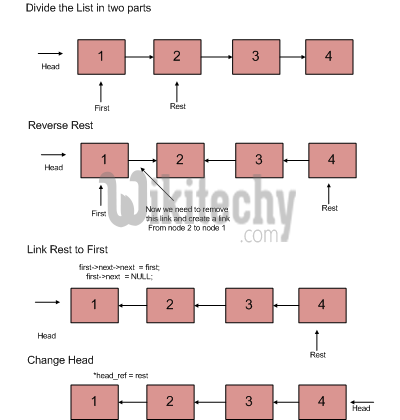Given pointer to the head node of a linked list, the task is to reverse the linked list.
Examples:
Input : Head of following linked list
1->2->3->4->NULL
Output : Linked list should be changed to,
4->3->2->1->NULL
Input : Head of following linked list
1->2->3->4->5->NULL
Output : Linked list should be changed to,
5->4->3->2->1->NULL
Input : NULL
Output : NULL
Input : 1->NULL
Output : 1->NULL
[ad type=”banner”]
Iterative Method
Iterate trough the linked list. In loop, change next to prev, prev to current and current to next
Python Programming:
# Python program to reverse a linked list
# Time Complexity : O(n)
# Space Complexity : O(1)
# Node class
class Node:
# Constructor to initialize the node object
def __init__(self, data):
self.data = data
self.next = None
class LinkedList:
# Function to initialize head
def __init__(self):
self.head = None
# Function to reverse the linked list
def reverse(self):
prev = None
current = self.head
while(current is not None):
next = current.next
current.next = prev
prev = current
current = next
self.head = prev
# Function to insert a new node at the beginning
def push(self, new_data):
new_node = Node(new_data)
new_node.next = self.head
self.head = new_node
# Utility function to print the linked LinkedList
def printList(self):
temp = self.head
while(temp):
print temp.data,
temp = temp.next
# Driver program to test above functions
llist = LinkedList()
llist.push(20)
llist.push(4)
llist.push(15)
llist.push(85)
print "Given Linked List"
llist.printList()
llist.reverse()
print "\nReversed Linked List"
llist.printList()
# This code is contributed by Nikhil Kumar Singh(nickzuck_007)
Given linked list
85 15 4 20
Reversed Linked list
20 4 15 85
Time Complexity: O(n)
Space Complexity: O(1)
[ad type=”banner”]
Recursive Method:
1) Divide the list in two parts - first node and rest of the linked list.
2) Call reverse for the rest of the linked list.
3) Link rest to first.
4) Fix head pointer

C Programming:
void recursiveReverse(struct node** head_ref)
{
struct node* first;
struct node* rest;
/* empty list */
if (*head_ref == NULL)
return;
/* suppose first = {1, 2, 3}, rest = {2, 3} */
first = *head_ref;
rest = first->next;
/* List has only one node */
if (rest == NULL)
return;
/* reverse the rest list and put the first element at the end */
recursiveReverse(&rest);
first->next->next = first;
/* tricky step -- see the diagram */
first->next = NULL;
/* fix the head pointer */
*head_ref = rest;
}
Time Complexity: O(n)
Space Complexity: O(1)
[ad type=”banner”]
Python Programming:
# Simple and tail recursive Python program to
# reverse a linked list
# Node class
class Node:
# Constructor to initialize the node object
def __init__(self, data):
self.data = data
self.next = None
class LinkedList:
# Function to initialize head
def __init__(self):
self.head = None
def reverseUtil(self, curr, prev):
# If last node mark it head
if curr.next is None :
self.head = curr
# Update next to prev node
curr.next = prev
return
# Save curr.next node for recursive call
next = curr.next
# And update next
curr.next = prev
self.reverseUtil(next, curr)
# This function mainly calls reverseUtil()
# with previous as None
def reverse(self):
if self.head is None:
return
self.reverseUtil(self.head, None)
# Function to insert a new node at the beginning
def push(self, new_data):
new_node = Node(new_data)
new_node.next = self.head
self.head = new_node
# Utility function to print the linked LinkedList
def printList(self):
temp = self.head
while(temp):
print temp.data,
temp = temp.next
# Driver program
llist = LinkedList()
llist.push(8)
llist.push(7)
llist.push(6)
llist.push(5)
llist.push(4)
llist.push(3)
llist.push(2)
llist.push(1)
print "Given linked list"
llist.printList()
llist.reverse()
print "\nReverse linked list"
llist.printList()
# This code is contributed by Nikhil Kumar Singh(nickzuck_007)
[ad type=”banner”]
Output:
Given linked list
1 2 3 4 5 6 7 8
Reversed linked list
8 7 6 5 4 3 2 1
